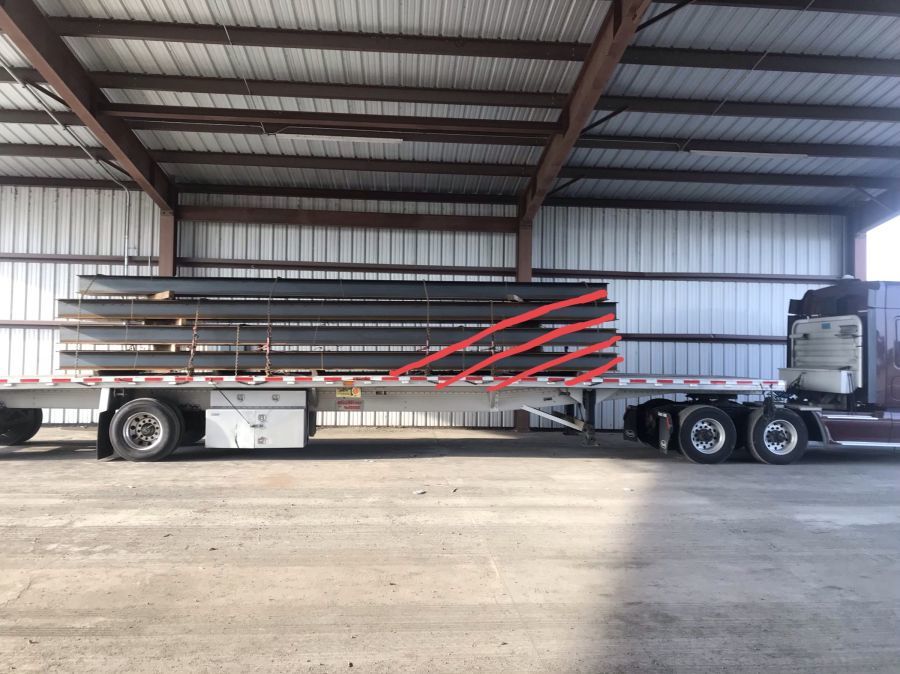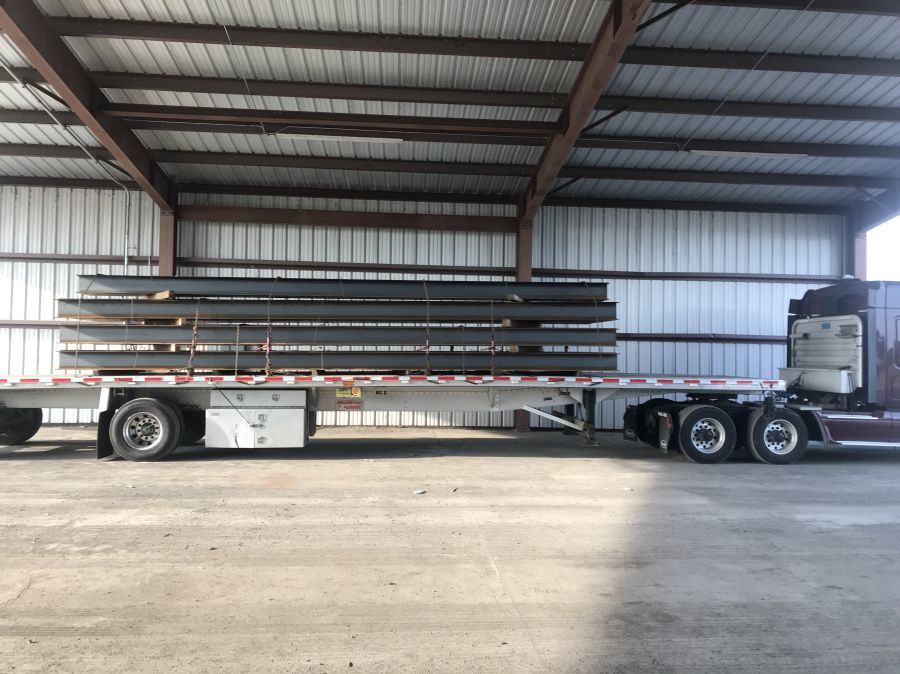Fatality Due To Apparently Improperly Secured Flatbed Load
Topic 26397 | Page 3

So, how do you three suggest a load like this be secured to prevent movement in a hard brake?
I give up, so why don’t you tell us?
Bulkhead , of course! Would a football player take the field without padding and a helmet? A baseball catcher without a face mask, shin guards and a chest protector?
Bulkhead:
A strong wall-like structure placed at the front of a flatbed trailer (or on the rear of the tractor) used to protect the driver against shifting cargo during a front-end collision. May also refer to any separator within a dry or liquid trailer (also called a baffle for liquid trailers) used to partition the load.
First off, can I say, Donald get off this thread. A bulkhead to every flatbedder on here is not what you are thinking of. We build our bulkheads. You are thinking of headboards or headache racks.
Now, as to letting someone else haul it, unfortunately, I was the someone else. That is another guy’s securement, and he refused to haul it. The only reason I have a picture is securement wanted to see the load when I got it.
X chains are almost worthless since there were several pieces in each layer and an x wouldn’t cover half of them. X chains are awesome for plate steel, though.
Bulkhead is good for the first layer, but it’s the top, middle beams I was most worried about. (Side note on bulkheads that I see a lot of guys screw up-they work when they are touching the material, a gap between the material and bulkhead makes it almost worthless.)
Headache rack-I have a solid one, but again, those top middle pieces were my biggest worry and they were higher than my rack. Besides, a headboard/headache rack, while slowing things down, is not a guarantee. One of the scarier things I saw last year was one of our shops removing a rack that had had shiny/greasy bar PUNCH through it. Sobering seeing how much force is there. (Driver was fine, improper securement issue.)
What I ended up doing was basically what turtle did, ran a trip chain over the end of each layer then secured them to the rub rail. Bottom two layers were easy, top two required marrying some chains to get the reach and they stretched back almost half the length of the load to get a workable angle on the chains. Then each layer got three wrap/cinch/choke straps to try to cinch every layer together. The rest of my straps and chains went over the top anywhere I had room.
I debated throwing some gut straps, but figured the cinch straps were doing the same job of pulling the layers down. May not be the right way (welcome to critiques), but I’ve done a few loads like this and seems to ride good. Load checks with those cinch straps are every hour.
Bulkhead:
A strong wall-like structure placed at the front of a flatbed trailer (or on the rear of the tractor) used to protect the driver against shifting cargo during a front-end collision. May also refer to any separator within a dry or liquid trailer (also called a baffle for liquid trailers) used to partition the load.
DAC:
Drive-A-Check Report
A truck drivers DAC report will contain detailed information about their job history of the last 10 years as a CDL driver (as required by the DOT).
It may also contain your criminal history, drug test results, DOT infractions and accident history. The program is strictly voluntary from a company standpoint, but most of the medium-to-large carriers will participate.
Most trucking companies use DAC reports as part of their hiring and background check process. It is extremely important that drivers verify that the information contained in it is correct, and have it fixed if it's not.
HOS:
Hours Of Service
HOS refers to the logbook hours of service regulations.OWI:
Operating While Intoxicated
Something kind of like this. Not sure if the angle would stop something, but it make me feel better.

Good visual. Do you haul this material consistently or is this a method you learned in training?

I've really got to step up my game. Recently hauling forming for concrete with a coating on thr plywood that is slick like formica. Any way the rear stact of 3 shifted and could have come off the trailer! NOT COOL!!! Should have used 2 or 3 belly straps across the 2nd piece then 4-5 straps over the top. Ok 5or6. Anyway it didn't fall off but was too close for my comfort. I do not have a headache rack. Just trust that I won't have to hard brake because most of the stuff I haul would just punch right thru the back of the cab and after removing my head would continue right on out the windshield. Nothing stopping it whatsoever. Gotta think about this. Glad I read the article! 😀
DAC:
Drive-A-Check Report
A truck drivers DAC report will contain detailed information about their job history of the last 10 years as a CDL driver (as required by the DOT).
It may also contain your criminal history, drug test results, DOT infractions and accident history. The program is strictly voluntary from a company standpoint, but most of the medium-to-large carriers will participate.
Most trucking companies use DAC reports as part of their hiring and background check process. It is extremely important that drivers verify that the information contained in it is correct, and have it fixed if it's not.
I never would drive flatbed without a headache rack. It won't stop everything, but it is a great buffer and bbn peace of mind.
DAC:
Drive-A-Check Report
A truck drivers DAC report will contain detailed information about their job history of the last 10 years as a CDL driver (as required by the DOT).
It may also contain your criminal history, drug test results, DOT infractions and accident history. The program is strictly voluntary from a company standpoint, but most of the medium-to-large carriers will participate.
Most trucking companies use DAC reports as part of their hiring and background check process. It is extremely important that drivers verify that the information contained in it is correct, and have it fixed if it's not.
New Reply:
New! Check out our help videos for a better understanding of our forum features

















Preview:
This topic has the following tags:
Advice For New Truck Drivers Flatbed Load Securement Photos Truck Driver Safety Trucking Accidents








 TT On Facebook
TT On Facebook
That poor old man might have been saved by a sturdy bulkhead on his flatbed trailer. I would have bulkheads as standard equipment if I were to own any flatbed trailers or flatbed straight trucks. Some dry vans even have bullheads installed inside.
CDL:
Commercial Driver's License (CDL)
A CDL is required to drive any of the following vehicles:
Bulkhead:
A strong wall-like structure placed at the front of a flatbed trailer (or on the rear of the tractor) used to protect the driver against shifting cargo during a front-end collision. May also refer to any separator within a dry or liquid trailer (also called a baffle for liquid trailers) used to partition the load.
Dry Van:
A trailer or truck that that requires no special attention, such as refrigeration, that hauls regular palletted, boxed, or floor-loaded freight. The most common type of trailer in trucking.